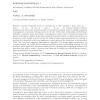Free Online Productivity Tools
i2Speak
i2Symbol
i2OCR
iTex2Img
iWeb2Print
iWeb2Shot
i2Type
iPdf2Split
iPdf2Merge
i2Bopomofo
i2Arabic
i2Style
i2Image
i2PDF
iLatex2Rtf
Sci2ools
143
click to vote
STOC
1995
ACM
1995
ACM
Transforming cabbage into turnip: polynomial algorithm for sorting signed permutations by reversals
Genomes frequently evolve by reversals (i, j) that transform a gene order 1 . . . iiϩ1 . . . jϪ1j . . . n into 1 . . . ijϪ1 . . . iϩ1j . . . n. Reversal distance between permutations and is the minimum number of reversals to transform into . Analysis of genome rearrangements in molecular biology started in the late 1930’s, when Dobzhansky and Sturtevant published a milestone paper presenting a rearrangement scenario with 17 inversions between the species of Drosophila. Analysis of genomes evolving by inversions leads to a combinatorial problem of sorting by reversals studied in detail recently. We study sorting of signed permutations by reversals, a problem that adequately models rearrangements in small genomes like chloroplast or mitochondrial DNA. The previously suggested approximation algorithms for sorting signed permutations by reversals compute the reversal distance between permutations with an astonishing accuracy for b...
Related Content
| Added | 26 Aug 2010 |
| Updated | 26 Aug 2010 |
| Type | Conference |
| Year | 1995 |
| Where | STOC |
| Authors | Sridhar Hannenhalli, Pavel A. Pevzner |
Comments (0)

